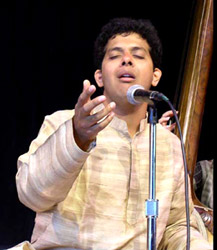 Thumri is the most important "light classical" genre of North Indian Classical music. It is performed in many contexts, from the sphere of dance, to the vocal concert stage, to performance on instruments. The reason behind calling Thumri light classical are many and varied. One of the prime reasons is that the melodies are not always composed in a Raaga and the may break the rules in singing those that are. It has also been suggested that simpler talas and less weighty raagas are used for thumri. Yet another likely reason is that alap-type improvisation is not cultivated in Thumri, and alap is the real test of good musicianship. In addition, Thumri is traditionally accompanied by a harmonium. As the artist sings, he pumps a bellows at the back of the harmonium and reproduces the vocal melody on the keyboard with the other hand. The fixed pitches that the harmonium is restricted to are considered a serious threat to traditional melodic flexibility. Whatever the reason, Thumri provides light, enjoyable music with which to end a vocal or instrumental concert.
Thumri is the most important "light classical" genre of North Indian Classical music. It is performed in many contexts, from the sphere of dance, to the vocal concert stage, to performance on instruments. The reason behind calling Thumri light classical are many and varied. One of the prime reasons is that the melodies are not always composed in a Raaga and the may break the rules in singing those that are. It has also been suggested that simpler talas and less weighty raagas are used for thumri. Yet another likely reason is that alap-type improvisation is not cultivated in Thumri, and alap is the real test of good musicianship. In addition, Thumri is traditionally accompanied by a harmonium. As the artist sings, he pumps a bellows at the back of the harmonium and reproduces the vocal melody on the keyboard with the other hand. The fixed pitches that the harmonium is restricted to are considered a serious threat to traditional melodic flexibility. Whatever the reason, Thumri provides light, enjoyable music with which to end a vocal or instrumental concert.Origins of Thumri
Thumri was cultivated primarily in Lucknow and Varanasi in the nineteenth century, and it is possible to pinpoint differences between the styles of Thumri from those two places. Other regional styles have developed as well, for example, that of Punjab. Nowadays, audiences prefer to hear female vocalists sing Thumri. A full performing ensemble includes harmonium, usually played by the vocalist, tambura, tabla, and probably a Sarangi.
Text of Thumri
The texts of Thumri are romantic. They refer perhaps to Lord Krishna and his amorous pranks, or to "the beloved," who may (or may not) be Krishna. Other texts are unequivocally romantic: they contain no allegorical suggestions. One of the main tenets concerning thumri is that the text is most important. Each word is pronounced clearly, and every bit of feeling the text might express is brought out musically. This is a major difference between Thumri and Khayal.
Structure of Thumri
A Thumri is a brief composition consisting of sthai and one or more antaras with improvisation. Usually, the "more antaras" are additional text, which is sung to approximately the same antara melody. Most Thumri, however, have only sthai and antara. The sthai phrase proper is used at cadences to close each singer's turn. After the several repetitions of the sthai in variant forms, the amount of improvisation on the sthai text increases gradually and the middle and upper registers are explored. In that respect, this performance is very similar to medium-speed khayal. The antara is sung when the upper register has already been introduced in the improvisation, and it is presented partially at first, as a Khayal antara is likely to be.
For more, visit the link below: